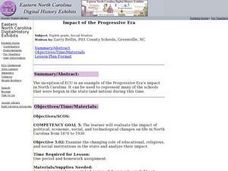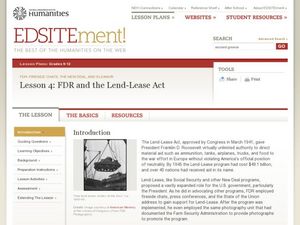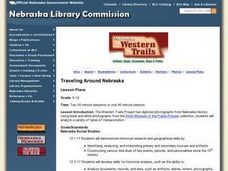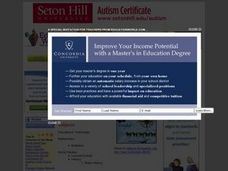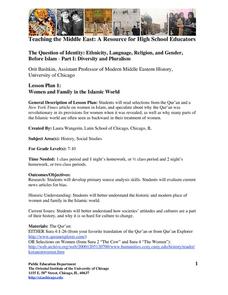Curated OER
Different Viewpoints - Loyalist or Patriot
Third graders use primary sources to study U.S. history and government. In this primary sources lesson, 3rd graders practice gathering information from "eye witness" accounts of history.
Curated OER
COMING TO AMERICA: THE NEW IMMIGRANTS
Learners become involved in the process of interpreting history by looking at primary source documents. This promotes critical thinking skills and comprehension of concepts and their relationships to different time periods through...
Curated OER
Impact of the Progressive Era
Eighth graders examine the impact of the Progressive Era on the state of North Carolina. Using primary source documents, they discover the reason for the creation of schools during this time period. After reading news articles, they...
Curated OER
FDR and the Lend-Lease Act
Students analyze primary source documents and photographs to analyze the implications of the Lend-Lease Program. In this research lesson plan, students read and discuss letters and speeches related to the Lend-Lease Act, evaluate FDR's...
Curated OER
Constitutional Issues: Civil Liberties During War
Students discuss democratic ideals and constitutional principles. They decide which side of the issue they are on dealing with the placement of Japanese-Americans in camps during World War II. They examine primary source documents for...
Curated OER
Prisoners in Another War
Students identify violations of the Geneva Convention in video clips. They discover the role of international bodies in dealing with war crimes. They read primary source documents as well.
Curated OER
Lorenzo de Zavala Online: Empresario, Statesman and Texas Revolutionary
Seventh graders study Lorenzo de Zavala's role in the Texas Revolution as politician and statesman. They determine his contributions to the establishment of a government as Texas fought for its independence. While completing research,...
University of Georgia
Energy Content of Foods
Why do athletes load up on carbohydrates the evening before a competition? The lesson helps answer this question as it relates the type of food to the amount of energy it contains. After a discussion, scholars perform an experiment...
University of Wisconsin
Analyzing Presidential Campaign Propaganda
Campaign propaganda has evolved from 1952 through the presidential election of 2008. A social studies activity prompts class members to analyze the devices used in ads and political cartoons, noting strategies they believe would work to...
What So Proudly We Hail
Life, Liberty, and the Pursuit of Happiness: A Lesson on the Declaration of Independence
What does it mean to say that a right is unalienable? How did the founding fathers convey this revolutionary concept in the Declaration of Independence? Engage in a close reading and analysis of the Declaration of Independence, and...
Historica-Dominion Institute
Artifact Creation Activity
Creating an artifact that is representative of a specific time period provides an opportunity for amateur historians to understand the importance of primary sources. This resource describes the process for students to explore original or...
National History Day
Why Did the United States Enter World War I in 1917?
World War I was the first major conflict on a global scale. Using primary documents, learners determine why the United States chose to enter World War I when it did. After analytical writing and group research, the causes of America's...
University of Georgia
Splat!
What does viscosity have to do with splatter? An activity shows that the viscosity of a substance is inversely proportional to the distance of its splatter. Learners conduct the experiment by collecting data, graphing, and analyzing...
Museum of Tolerance
Just What Kind of American Are You?
Your parents were both in different countries. You were born in the US. Documents and application forms ask you to identify your racial or ethnic classification. Which box do you check? Class members collect documents...
Pulitzer Center
The Global Water Crisis
High schoolers examine the "quiet crisis," the lack of clean water, by reading articles and viewing video clips. They discuss the situations in Ethiopia, Yemen, Kenya, and Nepal. There are two options for the lesson plan, but one of them...
Mascil Project
Epidemics: Modelling with Mathematics
The Black Death epidemic is responsible for more than one million deaths in the United Kingdom. An inquiry-based activity has young scholars explore the rate of disease spread. They then analyze graphs showing data from epidemics such as...
Open Oregon Educational Resources
Oregon Writes Open Writing Text
Are some resource books more confusing than helpful? The creator of Oregon Writes Open Writing Text thinks so. That is why the text remains a living document with input from teachers, librarians, and scholars. The eBook begins with...
Curated OER
Traveling Around Nebraska
Students analyze a current or historical photograph from their textbook and as a class complete a worksheet of the analysis. Using the Photographic Analysis Form, they locate and analyze two transportation photographs and use the...
Curated OER
Fly Away With Averages
Students discover the process of finding the mean, median, and mode. Through guided practice and problem solving activities, they use a computer program to input data and create a graph. Graph data is used to calculate the mean,...
Curated OER
Sadorus Photograph Collection Activity: Analysis of an Historical Photograph
Young scholars retrive social, cultural, and historical information from a photograph by analyzing the contents. Data about the subject's culture, people, events, and place is explored.
Smithsonian Institution
For Land's Sake: George Washington as Land Surveyor
Students discuss the importance of land ownership and the purpose of land surveying in the eighteenth century. They interpret a transcript of an eighteenth-century land survey. They survey and area of land. They create a written or...
Curated OER
In Congress Assembled: Continuity and Change in the Governing of the United States
Students interpret history using primary resources and secondary research. The Constitution is examined and changes are explained within the time period they were made.
Curated OER
Everybody Is a Winner in the Iditarod
Students read an article about the Iditarod winners. Using the document, they answer questions on a worksheet and examine the history of the race as well. They complete an activity using the internet to end the activity.
University of Chicago
Women and Family in the Islamic World
How does the Qur'an detail the role of women? What modern social issues are linked to Islamic law? Address these questions with your young historians through close analysis of primary and secondary source documents.


